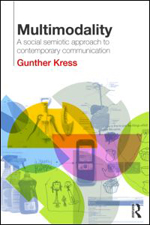Gunther Kress, Professor of Semiotics and Education at the University of London, illustrates the different domains of representation and communication.

Gunther Kress, Professor of Semiotics and Education at the University of London, illustrates the different domains of representation and communication.

The perspective of representation asks: ‘What is it that I wish to say, write, gesture, “express”, at this point?’, ‘What is my interest at this point in giving material shape and form to my meaning?’. Representation is focused on myself and my interest; communication is focused on my interest in its relation to others. With representation there is, first, something to which I want to give material realization, making some meaning tangible in the world. Second, the ‘take’ on what I wish to represent arises out of my interest: interest directs my attention to something that now engages me, at this moment. Third, my interest is shaped by my history, by my experiences over time in a set of communities and their cultures. And fourth, my interest is shaped by my sense of what is relevant to attend to in my social environment right here and now, in relation to this phenomenon or object. The question in representation is ‘what are the best, the apt means for giving material form, material realization to my meanings’. That is the ‘me part’ of representation.
Communication, by contrast, is to put the meanings to which I am giving material shape as a sign (as text) into an interrelation with others in my environment: to make my meanings known to my assumed audience. Now my interest has shifted from ‘me and the aptness of material forms to realizing my meanings’ to the environment of communication and to those who are participants in that: me with others. The questions change: ‘What is my relation to those with whom I am communicating?’, ‘Are they members of my more immediate social group or are they more ‘distant?’, ‘What are the relations of power and how do I need to acknowledge them in my signs?’, and ‘How ought I to adjust and shape my representation in relation to the interests of my assumed interlocutors?’. The issue is the rhetorical one: ‘How can I be most effective in disseminating my meaning so that others will engage (positively) with it?’
Both representation and communication are social processes, but differently so. Representation is focused on me, shaped by my social histories, by my present social place, by my focus to give material form through socially available resources to some element in the environment. Communication is focused on social (inter-)action in a social relation of me with others, as my action with or for someone else in a specific social environment, with specific relations of power. Interest remains central, but its focus, its direction and attention shifts: from ‘me and my focus on aptly representing some entity or phenomenon to my satisfaction’ to ‘me in inter-action with others in my social environment and my focus on success in engaging and persuading others’. Representation is oriented to self: communication is oriented to an other. Representation takes place in a social environment; communication constructs a social environment. Signs(-as-texts) are always shaped by both kinds of interests: by my interest in aptly realizing my meaning and my interest in aptly conveying it to an Other. …
Kress, Gunther. 2008. Multimodality: A Social Semiotic Approach to Contemporary Communication. London: Routledge. pp. 49-52, 26, 32-36. || Amazon || WorldCat